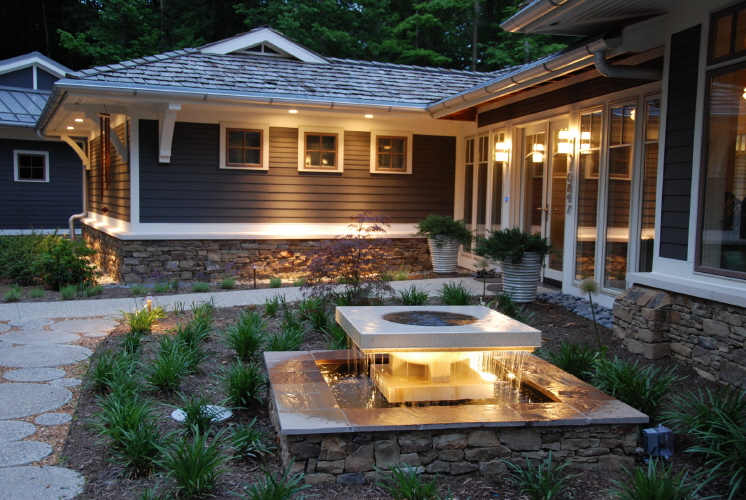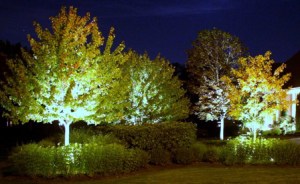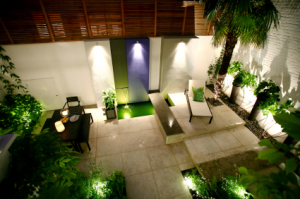Sing Moonlight and Roses while reading! Every morning as I take my predawn stroll down the front walk to retrieve the newspaper, decorative path lights illuminate my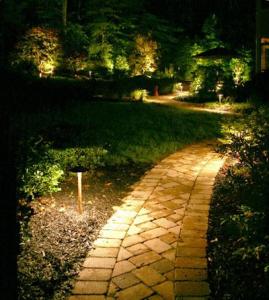 route. As I approach my house after dark I admire the soft glow of uplit tree canopies and the highlighted columns framing my front porch. Little did I realize when I installed landscape lighting in my yard a few years ago, how much I would appreciate and enjoy it. Like many people, I have invested a lot of time, effort, and expense into my landscape, creating an environment my family and I enjoy. With appropriate lighting, our enjoyment doesn’t have to end when the sun goes down. On those winter days when work or other commitments cause me to leave home early and get home late, the illuminated landscape is the only landscape I see.
route. As I approach my house after dark I admire the soft glow of uplit tree canopies and the highlighted columns framing my front porch. Little did I realize when I installed landscape lighting in my yard a few years ago, how much I would appreciate and enjoy it. Like many people, I have invested a lot of time, effort, and expense into my landscape, creating an environment my family and I enjoy. With appropriate lighting, our enjoyment doesn’t have to end when the sun goes down. On those winter days when work or other commitments cause me to leave home early and get home late, the illuminated landscape is the only landscape I see.
Three primary functions of landscape lighting are:
Aesthetics – Highlighting distinctive plants, site elements or architectural features.
Safety – Illuminating a step, path, or potential hazard.
Security – Making an area more visible.
A typical landscape lighting installation may attempt to incorporate facets of all three. As I analyze a site for lighting potential, I consider several types of techniques:
- Path lighting
- Tree lighting
- Architectural lighting
- Moonlighting
- Spotlighting
Path Lighting
It illuminates or highlights a route. It may be the walk to the front door or an informal stepping stone garden path. It is particularly useful when drawing attention to steps. Appropriate fixture spacing will vary depending on the fixture and the desired effect, but is typically 8-15 feet. Many fixture styles are available. Some are simple and subtle and not meant to draw attention to themselves. Others are more stylish or even sculptural and meant to draw attention to themselves. Either can be appropriate for the setting. Personal preference prevails. Some fixtures direct light to the ground in a way that the light source is not visible. A glow on the ground is all that’s seen. Others are designed so that the light source is visible. Again, personal preference will dictate what style is used. If possible, avoid placing path lights in a lawn where they are vulnerable to damage from mowers.
Good candidates for lighting are trees with dense and/or interesting branching structure or decorative bark. Multi-stem trees are almost always nicely lit. A light (or lights) shining up into the tree creates an interior glow. The location and angle of the fixture determines how much of the trunk is illuminated. Preference varies depending on the tree and desired effect. Not good for lighting are most conifers, tall trees with lowest branches not starting until fifteen feet or more above the ground and spindly poorly branched trees.
This typically involves illuminating parts of a house. While lighting catalogs often show the entire front face of a house aglow from the beams of multiple spotlights, I find a more subtle, less brash look more appealing, with only certain features being highlighted. Columns on a front porch for example can be effectively lit. Combined with the impact of recessed ceiling or wall mounted porch lights a front door can be nicely showcased. Bare wall areas can be “grazed” by narrow beamed spotlights placed tight against the wall creating an attractive vertical glow. Care should be taken that light doesn’t disturbingly shine through windows into the house.
Moonlighting
This somewhat specialized effect requires a rather mature tree to mount a light fixture in, and a surface below that is deserving of being put awash in a soft glow of light (like moonlighting). Ideally, the tree will have a trunk or branch of at least six inches in diameter to affix a fixture (in a manner minimally impacting the tree and accommodating the future growth) at a height of a least fifteen feet. The tree will also ideally have some lower branches below the fixture through which the beam passes, thus creating some shadow play on the ground below. Typically, the light would be shining down onto a terrace. Moonlighting is not meant to create enough light to read by, but rather to be able to see and engage with others…to set a mood.
Spotlighting
Often a landscape contains certain special features that are deserving of enhancement. Sculptures and water features are examples of items that might want 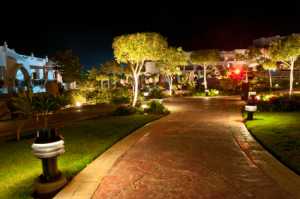 to be lit for after dark enjoyment. Fixture placement and lamp selection are important considerations. A fixture at ground level shining up at the feature is most common, though if there is an opportunity to mount a fixture on a wall or in a tree, a downward beam might have the best impact. The selected lamp will want to illuminate only the feature and minimal its surroundings. A narrow beam spread is most often appropriate.
to be lit for after dark enjoyment. Fixture placement and lamp selection are important considerations. A fixture at ground level shining up at the feature is most common, though if there is an opportunity to mount a fixture on a wall or in a tree, a downward beam might have the best impact. The selected lamp will want to illuminate only the feature and minimal its surroundings. A narrow beam spread is most often appropriate.
A nicely lit landscape often has elements of all of these techniques. In combination they might find you enjoying your outdoor spaces as much on a cold winter night as in a warm summer day. Just as a garden should be designed to provide year round interest, extending that interest into the night should be a standard goal.
This conversation has only addressed the visual possibilities of landscape lighting and not the important technical and installation issues that bring it to reality. Lighting is typically and under-appreciated and overlooked aspect of the landscape, but once in place, always enjoyed.

